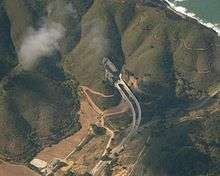Tom Lantos Tunnels
|
The construction of the North Portal Bridges leading to the tunnels, that bypass Devil's Slide | |
| Overview | |
|---|---|
| Location | Near Pacifica, California |
| Coordinates | 37°34′38″N 122°30′45″W / 37.5772°N 122.5125°WCoordinates: 37°34′38″N 122°30′45″W / 37.5772°N 122.5125°W |
| Status | Complete |
| Route |
|
| Operation | |
| Work begun | May 6, 2005 |
| Constructed | 2005-2013 |
| Opened | March 26, 2013 |
| Owner | State of California |
| Operator | Caltrans |
| Traffic | Automotive |
| Technical | |
| Length |
4,149 ft (northbound) 4,008 ft (southbound) |
| Number of lanes | 1 per bore |
| Operating speed | 45 mph (72 km/h) |
| Highest elevation | c. 30 m (98 ft) msl |
| Lowest elevation | c. 20 m (66 ft) msl |
| Tunnel clearance | 6.8 m (22 ft) |
| Width | 9 m (30 ft) |
The Tom Lantos Tunnels are two tunnels located within the coastal promontory of Devil's Slide in California, United States, allowing State Route 1 to bypass the treacherous Devil's Slide stretch. They are officially named after late Congressman Tom Lantos, who was instrumental in securing funding for the project, but de facto named after their location.
The Devil's Slide tunnels, as they are usually called, are the second and third longest road tunnels in California at 4,149 ft (1,265 m) northbound, and 4,008 ft (1,222 m) southbound. By comparison the longest road tunnel currently in California, the Wawona Tunnel on Highway 41 in Yosemite National Park, is 4,233 ft (1,290 m).
History of the highway rebuilding conflict
A bypass was proposed to be constructed to replace the 600-foot (180 m) stretch of highway. Beginning in 1958, California began the process to replace Devil's Slide with an inland route over Montara Mountain, known as the Martini Creek Bypass. The bypass bisected a section of McNee Ranch State Park, and was opposed by community and environmental groups. By 1975, 55% of the right-of-way had been acquired, when work on the proposed bypass was abandoned due to public opposition.
Most environmentalists supported a tunnel as a more environmentally sensitive alternative to the Martini Creek Bypass. A short tunnel built in 1908 by the Ocean Shore Railroad went through the area, but was destroyed during Prohibition, to keep it from being used by alcohol smugglers. The Sierra Club proposed building a tunnel to bypass the road in 1973. A Caltrans study in 1974 determined that a tunnel would be a viable alternative to the current road or a proposed inland freeway bypass. However, the state dropped the idea in the late 1970s.

A major slide in 1983 brought the problem to the public attention again. In 1985 Caltrans proposed the Martini Creek bypass as the preferred solution. However, the Sierra Club sued to stop construction, as California law requires that State Route 1 be restricted to two lanes in rural areas. The 101-foot-wide (31 m) road bed, complete with continuous uphill passing lanes, runaway truck ramps, and extra-wide shoulders, would be the widest two-lane road in the state. Again the state decided to return to the status quo.

A five-month outage caused by a slide in January 1995 again brought public scrutiny to the stretch of highway. In April, Caltrans documents were discovered that showed the agency had intentionally overestimated the costs of a tunnel, to support the freeway bypass. In July, the Federal Highway Administration ordered Caltrans to re-evaluate a tunnel to bypass Devil's Slide. On November 5, 1996, San Mateo County voters approved Measure T by 76%, changing the county's stated preference from construction of the bypass to construction of a tunnel. On November 9, Caltrans changed its position, supporting a bridge and tunnel as the best environmental, economic, and popular alternative to Devil's Slide.
Ground was broken for the new tunnel on May 6, 2005. Boring of twin 30-foot (9 m) diameter tunnels started September 17, 2007, and was completed in 2011.[1] Breakthrough on the northern bore occurred on September 30, 2010.[2] With the completion of the tunnels in 2013, the old Devil's Slide highway was converted into a trail for hikers and bicyclists.[3] The tunnels opened to traffic on March 26, 2013.[4]
References
- ↑ Michael Cabanatuan (4 August 2011). "Devil's Slide tunnel work falls behind schedule". The San Francisco Chronicle. Retrieved 21 March 2013.
- ↑ Lily Bixler (14 February 2012). "Workers break through tunnel preemptively". The Half Moon Bay Review. Retrieved 21 March 2013.
- ↑ Ryan Kim (May 6, 2005). "SAN MATEO COUNTY / Tunnel was devil of a fight / Caltrans breaks ground today on long-sought bypass at notorious slide". The San Francisco Chronicle. Retrieved 21 March 2013.
- ↑ Michael Cabanatuan (14 March 2013). "Devil's Slide Tunnel to open March 26". The San Francisco Chronicle. Retrieved 21 March 2013.
Further reading
- Michael Hogan and Ballard George, Air Quality and Noise Analyses for the Bypass Alternative, Devil's Slide Improvement Project, Caltrans District 4, prepared by Earth Metrics Inc., Burlingame, CA (1984)
- Devil's Slide Improvement Project, San Mateo County, California, Draft Second Supplemental Environmental Impact Statement, Caltrans District 4 (1999)
- Hovland, John H., Ph.D., P.E., A Study of the Feasibility of Stabilizing the Landslide Area Along Highway One, San Mateo County, California, by Dewatering, April, 1998
- Woodward-Clyde Consultants, Devil’s Slide Tunnel Study - Feasibility Report, October, 1996.
External links
| Wikimedia Commons has media related to Devil's Slide (California). |
| Wikisource has original text related to this article: |
- Caltrans Office of Geotechnical Design West engineering analysis
- Caltrans page for the Devil's Slide tunnel project
- Yes on T site
- KQED QUEST photo montage and article on tunnel